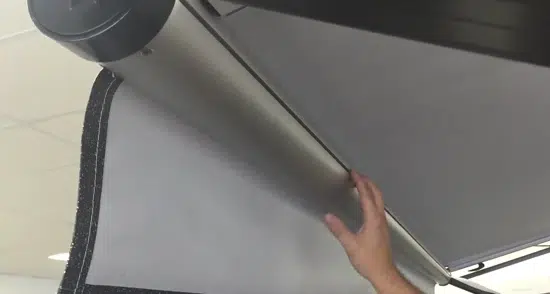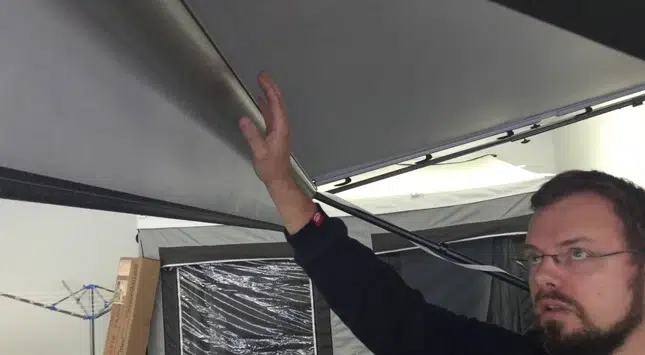Last Updated on April 11, 2023
After a rainfall, you may notice water accumulating on your RV awning. While this may not seem like a big deal, over time, it can cause irreparable destruction to your awning fabric and even lead to fungal growth.
Getting rid of this situation requires you to understand how to stop water pooling on the awning in the first place. In this way, you can take the necessary measures to protect the awning and keep it in good condition for an extended period of time.
You should also understand why the water is pooling so as to eliminate the problem from its source. We will go over all of this information so that you are able to maintain the canopy in optimal working order.
How to Stop Water Pooling On Awning? Some Effective Methods

Once you have determined the cause of pooled water within your RV canopy, you will be able to take appropriate steps to fix the problem.
There are a few different things that you can do to prevent pools of water, depending on the cause. Let’s look at some of the most effective solutions in order to keep your canopy in good condition.
Method 01: Lower the Angle
You should examine the angle or pitch of an RV awning to determine whether water is pooling there. If the awning is too horizontal, then water will collect on it.
The awning should be at a 45-degree angle so that the water can run off easily. If you are using a manual canopy, it will be necessary to adjust it by hand. Simply loosen the adjustment screws on the side of the canopy and lower it.
After that, spray water on the canopy to see if it works. Lowering the angle even further may be necessary if the water still collects in the midst. When you are finished, tighten the screws again.
With an electric awning, it is possible to adjust its position with the remote control. For angle adjustment, simply hold the down button until the desired angle is reached. This will help to solve the problem associated with pooling water.
Method 02: Increase the Tension
If your RV canopy is still pooling after adjusting the pitch, you may need to tighten the canopy. It must be tight in order for it to work properly. You can enhance the tension of a recreational vehicle awning in a few different ways.
To tighten awnings, check the manufacturer’s instructions to determine the maximum amount of tension that can be applied. You may wish to raise the tension of the awning by hand if it is not already at the maximum.
In order to accomplish this, simply rotate the canopy roller in the direction that will tighten the canopy. Guy rope may also be used to increase tension.
First, locate the grommet holes on the awning if you wish to use the rope. Afterward, you should wind the rope around the awning roller and through the grommet holes.
Once you have done this, tighten the rope until it is snug. As a result, the canopy will be kept tight, and water will not pool. Another option is to use a pool noodle. Add this tool to the center of your awning, and the water will flow away quickly.
Method 03: Add a Rain Gutter
In case you are still experiencing problems with water pooling, you might consider installing a rain gutter on the RV canopy. It is a pipe that runs along the edge of your canopy and drains water away from the fabric.
Consequently, you will be able to keep the fabric dry and prevent water from collecting on the surface.
Make sure to choose a rain gutter that is the right size for your awning. You should also install portable gutter brackets so that you can easily remove them.
It is advantageous to have the ability to simply remove the rain gutter and brackets when retracting the canopy and store them until you need them again.
Method 04: Use a Water Repellent
You can also apply a water-repellent coating to keep rain from gathering under your awning. The application of a water repellent will help create a barrier between the fabric of an awning and the water, which will bend up and roll off the surface.
There are a number of different water repellents on the market, so it is important to pick one that is designed for use on an RV awning.
For applying the repellent, you will have to clean the awning first with soap and water. Let the awning dry completely after cleaning it. Then, apply the water repellent to the awning according to the manufacturer’s instructions.
Generally, you may apply the repellent using a sponge, brush, or spray. After spraying the repellent, allow it to dry completely before using the canopy.
Method 05: Use a Pole
You can try using a pole stick in the middle of the canopy. Doing so will avoid the fabric from sagging at the center and allow water to run off more easily. Simply place the stick on the middle end of the canopy where the attachment points are located.
Make sure that the pole is long enough to upper the canopy fabric at its midpoint. You can then use bungee cords or rope to secure the stick in place. Although this is a temporary solution, it can effectively prevent pools of water from forming.
Why Does Water Pool on RV Awnings?

Many factors may contribute to the accumulation of water within your motorhome canopy after heavy rain. Having knowledge of all these reasons will assist you in taking the necessary precautions to protect your awning.
If the problem is not addressed, the pooling of water will continue and result in further discomfort and degradation. Let us discuss some of the most common causes of water pooling so you can become aware of them.
1. Inadequate Pitch
If you observe water pooling around your awning, it could be due to inadequate pitch. The pitch refers to the angle at which your canopy is installed.
In the event the awning has not been installed at the correct angle, rainwater will run down the fabric and pool in the center rather than drain off to the sides.
It should be slightly angled so that rainwater will run off. You can adjust the pitch by tightening or loosening the screws on the awning’s side.
2. Poor Tension
Water can pool on the awnings because of poor tension. When the canopy is not tight enough, it sags toward the middle and does not shed water properly. As a result, rainwater can collect on the fabric, eventually causing it to leak or even collapse.
Insufficient support is one common cause of inadequate tension on RV awnings. The awning needs to be securely attached to the RV in order to provide the tension necessary to keep it from flapping in the wind.
If the canopy cannot be properly secured, it will not have the strength to withstand strong winds and will eventually start to sag.
An improperly installed retractable awning is another cause of poor tension. Unless the canopy is installed correctly, it may fail to provide the correct amount of tension.
It is vital to regularly check the awning’s tension and make adjustments as needed. Take these simple precautions, you can help extend the life of your awning and prevent major repairs.
3. Stretched Fabric
Over time, the awning fabric will gradually stretch and become less able to withstand the water’s weight. The stretching can cause the fabric to lose its shape, which can also lead to pooling.
If your canopy starts to sag or stretch, it’s important to have it repaired or replaced as quickly as possible. Otherwise, you may find yourself dealing with water damage on your next camping trip.
Frequently Asked Questions:
Regarding RV awnings and water pooling, there are several questions that are regularly asked. Let’s take a look at a few common inquiries and their answers.
1. How Long Does an RV Awning Last?
On average, an RV awning will last between five to fifteen years. However, several factors can affect the lifespan of an awning, including the type of awning fabric, the frequency of use, and the level of care and maintenance.
The best way to prolong the life of a motorhome awning is to clean it regularly and store it properly when it is not in use. By taking these simple steps, you can help your canopy last longer and will provide plenty of enjoyment.
2. Do RV Awnings Need to be Lubricated?
Yes, RV awnings do require lubrication. The rollers, springs, and moving parts of an awning can become dry and sticky over time. This can cause the awning to malfunction or break.
To make sure your awning remains in good working condition, make sure you lubricate all of the moving parts regularly. You can use various lubricants, such as WD-40, silicone spray, or a product specifically designed for RV awnings.
3. How Often Should I Clean My RV Awning?
Cleaning your RV canopy will depend on how often you use it and where you store it when not in use. If you live in an area with a lot of dust or pollen, you’ll need to clean it more often.
Similarly, if you frequently take your RV out in the woods or other areas prone to tree debris, you should wash more frequently to prevent the build-up of sap and other materials that can damage the fabric. In general, you should be able to get away with cleaning your canopy every few months.
Inspect it regularly for any signs of mildew or other damage, and clean it immediately if necessary. With a little care, it will last for a considerable period.
4. Can Awnings Be Used In Winter?
Awnings can be used during the winter months, but require special care and attention. If you intend to use a canopy, you should choose a material that is corrosion-resistant, such as aluminum or galvanized steel. These metals will not rust when exposed to snow and ice.
You should regularly lubricate all the moving parts on your awning to prevent freezing. Normal fabric awnings should not be utilized during the colder seasons because they are more likely to undergo damage from the weather.
When using fabric awnings, be sure that the frame is strong enough to support the weight of the snow and ice.
Conclusion
It is common for awnings to accumulate water, but this does not have to ruin your day. After reading this article, we hope that you clearly comprehend how to stop water pooling on an awning.
Follow the steps outlined in this article to prevent water from pooling as soon as you spot it. During the next rainstorm, put these tips into practice and enjoy a dry day beneath your awning.
Ensure that your canopy is cleaned and lubricated regularly to prevent any future malfunctions. Observing these instructions will help you to maintain your awning so that it lasts as long as possible.



